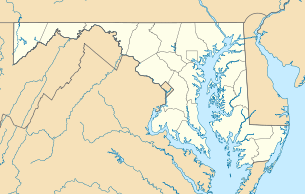Catoctin Furnace
|
Catoctin Furnace Historic District | |
 | |
 | |
| Location | Catoctin Furnace, Maryland |
|---|---|
| Coordinates | 39°34′35″N 77°26′2″W / 39.57639°N 77.43389°WCoordinates: 39°34′35″N 77°26′2″W / 39.57639°N 77.43389°W |
| Built | 1774 |
| Architect | Unknown |
| Architectural style | No Style Listed |
| Governing body | State |
| NRHP Reference # | 72000578 |
| Added to NRHP | February 11, 1972[1] |
Catoctin Furnace (also known as Catoctin Iron Furnace) was constructed in 1774 by four brothers Thomas, Baker, Roger and James Johnson to produce pig iron from locally mined hematite.[2][3] In blast by 1776, the furnace provided ammunition (cannonballs) for the American Revolution. Some sources state that it also provided cannon.[4][5][6] They also state that iron from this furnace was (much later of course) used to make plates for the USS Monitor; however that is considered unlikely by researchers.[7] The Johnson brothers owned the furnaces at the site at first collectively, and after 1793 singly, until 1811.[8]
Ultimately, three furnaces were built at the site, each named for the site. The first Catoctin Furnace was rebuilt a short distance away in 1787.[8] The second, named Isabella was built in the 1850s by Jacob Kunkel (references give dates from 1853 to 1867). It still stands, within Cunningham Falls State Park.[9]
The first two furnaces burned charcoal.[10] The third, which opened in 1873, burned coke[11] (some sources say anthracite coal, though this would be more costly[3][12]). The entire complex closed in 1903 (attributed to rising costs and the too-late introduction of a rail link).[6][13][14]
The furnace's remains are located in Cunningham Falls State Park. A walking-tour handout is available in the park's visitor center.
See also
- Catoctin Mountain
- Cunningham Falls State Park
- Thomas Johnson (governor)
References
- ↑ "National Register Information System". National Register of Historic Places. National Park Service. 2008-04-15.
- ↑ "Records Relating to Pre-National Zoological Park Purchases". Smithsonian Institution.
- ↑ 3.0 3.1 T. J. C. Williams (1979). History of Frederick County, Maryland. Genealogical Publishing Com.
- ↑ George Ernest Barnett (1902). State Banking in the United States Since the Passage of the National Bank Act. Johns Hopkins Press. p. 46.
- ↑ "Catoctin Iron Furnace". Greater Emmitsburg Area Historical Society.
- ↑ 6.0 6.1 George Wireman. "Gateway to the Mountains — Chapter 3: The Catoctin Iron Works". Greater Emmitsburg Area Historical Society.
- ↑ Edmund F. Wehrle (March 2000). "Catoctin Mountain Park Historic Resource Study — Chapter Three: Civil War and Decline of Industry". U. S. National Park Service. Retrieved 2007-09-30.
- ↑ 8.0 8.1 James Moore Swank (1884). History of the Manufacture of Iron in All Ages. p. 194.
- ↑ "Catoctin Furnace at Cunningham Falls State Park". The Journey Through Hallowed Ground. Retrieved 2007-09-27.
- ↑ "Catoctin Iron Furnace". U. S. National Park Service.
- ↑ Directory of Iron and Steel Works of the United States and Canada. American Iron and Steel Institute. 1890.
- ↑ Maryland Board of World's Fair Managers (1893). Maryland, Its Resources, Industries and Institutions. Sun job office.
- ↑ "Catoctin Furnace at Cunningham Falls State Park". Maryland Department of Natural Resources. 2002-08-28.
- ↑ "Civil Engineering in Maryland — Catoctin Furnace". The Johns Hopkins University.
External links
| Wikimedia Commons has media related to Catoctin Furnace. |
- WESTERN REGION Catoctin Mountain Byway
- Bringing history into classrooms: Reconstructing a colonial supply chain
- Catoctin Iron Furnace - No Time For War
- Cunningham Falls State Park: Catoctin Furnace
- Catoctin Furnace at Cunningham Falls State Park
- Historic American Buildings Survey (HABS) No. MD-478, "Catoctin Furnace, Stack No. 2, U. S. Route 15, Catoctin Furnace vicinity, Frederick County, MD", 1 photo, supplemental material
- Catoctin Furnace Historic District NRHP Nomination Form at Maryland State Archives
| |||||||||||||||||||||||||

